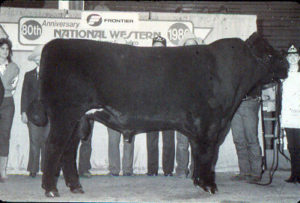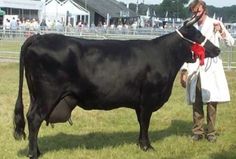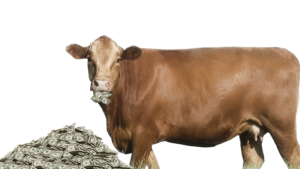I caught some flack for my extremism in Balance Is Bull. It was known it would; the post was to start a conversation and it served it’s purpose.
A little clarification may be in order.
Everything with cattle is intertwined. There are so many factors and variables that it is difficult to say that one thing is always going to happen or a certain result. There isn’t much in cows that is as certain as death and taxes.
So where should the extremes be and where should there be moderation?

Bull from the 1980 National Western Stock Show.

Hereford bull from 2012. Notice the Grand Champion ribbon? People breed for this!

From 2014. Again, notice the Grand Champion banner/ribbon thing!
Over 20 years–24 to be precise–and the bulls are about the same size. It goes across all breeds, too. This isn’t just an “Angus thing” or “Hereford thing.” Although any breeds that didn’t have black before, but now have black versions….that’s Angus. (Another post).
In speaking of cattle traits–bulls especially–moderation has been what everyone has been told to go for. As stated in Balance Is Bull, I call bull! Using a moderate-trait bull gives moderate results. Trying to balance maternal, performance, and carcass traits makes for average, median animals.
I understand the purpose. Producers want to sell their steers as feeders, but they want to keep heifers for replacements. This results in this “balance,” where steers are just good enough to get the buyers to pay for them; and heifers are just good enough to roll back into the herd.
The biggest issue I have is with the producers that buy these bulls with high performance traits and then keep the heifers. It’s like them using a highlighter to mark through that ugly red double-underlined number at the end of the year. It doesn’t happen right away. It takes some years sometimes. But it happens. The larger cows make larger calves, the larger calves make larger cows.
So what is the solution? The solution is to set goals, be extreme in those goals, and stick with them. Have a plan, have a means. Don’t wing it.
When thinking of extremes, I believe there are two things that should be concentrated on and looked at as a base criteria as to what decision should be made regarding any matter. Those two things are sustainability and profitability. If the decision is going to lead to the operation not being sustainable or profitable, it should absolutely be looked at more closely.
Side note: There are things more important that money. If the decision is being made between attending a child’s birthday party or brand calves, pretty sure the birthday party is more important….although having the birthday party at a branding could be pretty cool… But I digress…
So where does being extreme and being moderate fall into cattle breeding and cattle genetics? Here’s what I came up with, walking through the field while irrigating…
Be extreme in a category of traits by animal type. What I mean by that is have cows that are extreme in maternal traits; have bulls that are extreme in the traits that are in line with your goals for your herd. If you are building cows, use bulls that are strong in maternal traits; if you are selling calves at weaning, use bulls that are strong in performance; and if going to the rail or fork, go ahead and use those carcass bulls.
Where moderation comes in would be in some of the traits within the categories. Only a few of the traits need to be moderated, really. Milk. Milk should be moderate. You don’t want too little milk, since a calf needs milk to grow and will be stunted if it doesn’t get enough nutrition in the first 3 months of life. If you get too much milk, it’s like having a vehicle that you can watch the gas gauge go down when you romp on it. There are some differences of opinions on milk, I’ll get into those in later posts.
I’m going to step out there and say this cow

I’m going to step out there and say this cow probably produces more milk than is needed to raise a calf.
If you are selling calves at weaning to stockers and feeders, you may want to think about moderating calving ease, giving up a bit, to get a little more size. As I showed in But She’s A Good Cow, (possibly a cow will only put as much weight on a calf as she is going to put? May have to explore that at some point) the only difference in the weights of the two calves produced by the cow were the birth weights; the calves gained the same pounds, attributing the small difference to one calf being a heifer, one calf being a steer, in their young lives–and they were out of different bulls etc.
If you are going to the rail or fork, maybe you would be better to give up some pounds to get better marbling and larger ribeye? You’d have to put a pencil to it and see what the trade off/cost-benefit really would be. Is the premium for that increase in grade going to be worth more than the extra pounds? What about extra days on feed for one animal vs. harvesting another after less days? There are a lot of things to consider.
Figuring out what trade offs to make–nothing can be perfect–within a category is hard enough, without having to try and “balance” traits so that the steers will be just good enough for feeders and the heifers still be just good enough for breeding.
One thing to remember: They are all edible. They can be eaten. So even if you are using a “cow maker” bull, you will still get money for the steers. If you are building the best cows, you will most likely give up some on weaning weight. Large weaning weights lead to large mature weights. Large mature weights leads to higher nutrition/maintenance requirements.
Cash is required to pay the bills, though, so giving up as much weaning weight at would be required to make the very best cows may not be an option (remember, sustainable and profitable….if you can’t pay the bills, the operation isn’t sustainable). But better cows are still better than high-maintenance, less (not) profitable cows. Improvement is the goal, but the improvement has to within the resources and means of the operation.

No matter where you are with your cow herd, there is always room for improvement. Just make sure that the goals you set are what is really going to be sustainable and profitable; and make sure you are using the right measuring stick for improvement along the way. More on that at another time.
Cow Cow Ranch definition of SUSTAINABLE: Production of food for human consumption through the utilization of natural, renewable resources in a way that does not diminish the resources’ abilities to regenerate. A sustainable operation must produce enough income to pay for it’s own expenses, debt load (if any), and make a return on the capital invested. Sustainable beef production is socially, environmentally, and economically responsible.
I did want to add: one of the things to NOT be extreme on is size. Ironically, this is a subjective topic. I think I will have to do a whole post on it. Another deep topic.



